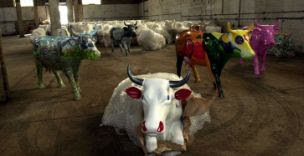
RIGHT: Leviathan was an aggressive 17m-long predator which may have preyed on other whalesWednesday, 30 June 2010 18:02 UK
Researchers have discovered the fossilised remains of an ancient whale with huge, fearsome teeth.
Writing in the journal Nature, the scientists have dubbed the 12 million-year-old creature "Leviathan".
It is thought to have been more than 17m long, and might have engaged in fierce battles with other giant sea creatures from the time.
Leviathan was much like the modern sperm whale in terms of size and appearance.
But that is where the similarity ends. While the sperm whale is a relatively passive animal, sucking in squid from the depths of the ocean, Leviathan was an aggressive predator.
According to Dr Christian de Muizon, director of the Natural History Museum in Paris, Leviathan could have hunted out and fed on large sea creatures such as dolphins, seals and even other whales.
"It was a kind of a sea monster," he said.
"And it's interesting to note that at the same time in the same waters was another monster, which was a giant shark about 15m long. It's possible that they might have fought each other".
The researchers speculate that Leviathan was able to feed on very large prey up to 8m long. It would catch the prey in its huge jaws and tear it apart quickly and effectively with its giant teeth.
A 3m-long fossilised skull of the creature was discovered by researchers in southern Peru in 2008. Dr de Muizon's student, Olivier Lambert was among them.
"It was the last day of our field trip when one of our colleagues came and told us that he thought he'd found something very interesting. So we joined him and he showed it to us," he said.
"We immediately saw that it was a very large whale and when we looked closer we saw it was a giant sperm whale with huge teeth."
The teeth were more than twice the length and diameter of those found in modern sperm whales and they were on the upper and lower jaws.
Sperm whales only have teeth on their lower jaw.
Dr Lambert and his colleagues had speculated that such a fierce creature might once have existed on the basis of discoveries of individual teeth.
Now, the discovery of the skull means that the Leviathan is not merely the stuff of myth and legend.
"Finally we found it," said Dr Lambert. " It was a very exciting moment".
The researchers do not know why this ancient whale died out. They speculate that the ecology and environment changed so that the creature had to change its feeding habits.
That may have led to the emergence of today's much gentler sperm whales, with the carnivorous niche filled by killer whales as conditions swung back again.
The authors of the report in Nature, who are all whale experts, are fans of the novel Moby Dick, which involves a ferocious white sperm whale.
So taken are they with the novel that they decided to dedicate their discovery to the author, Herman Melville, and give the creature its full scientific name of Leviathan melvillei.
http://news.bbc.co.uk/1/hi/science_and_environment/10461066.stm




















